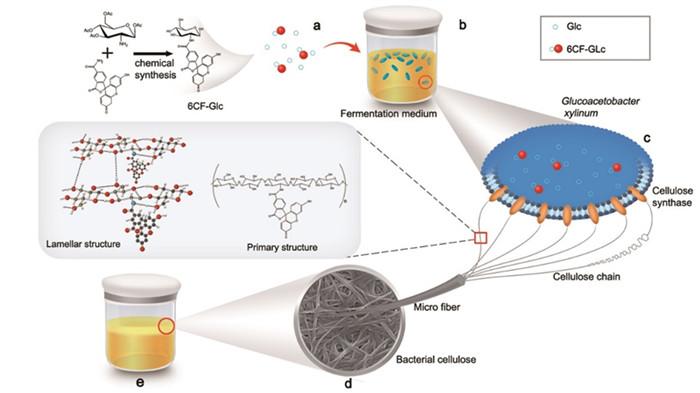
Credit: GAO Minghong
Bacterial cellulose (BC) is a cellulose material produced by microbial fermentation with a unique porous network structure. Functionalized BC has application prospects in many fields, such as chemical sensing, biological imaging, and oil adsorption.
At present, BC is often functionalized through physical coating or chemical modification. Physical coating can provide a mild modification condition, but functional moieties potentially suffer from shedding. Chemically modified materials are difficult to implement for industrial-scale production, due to their poor performance and serious environmental pollution.
Recently, a research team led by Prof. XIAN Mo and ZHANG Haibo from the Qingdao Institute of Bioenergy and Bioprocess Technology (QIBEBT) of the Chinese Academy of Sciences developed a new method for bacterial cellulose functionalization.
BC with unnatural fluorescent functionality was obtained through in situ fermentation of Komagataeibacter sucrofermentans (K. sucrofermentans, a microorganism that produces BC), using 6-carboxyfluorescein-modified glucose (6CF- Glc, a modified glucose molecule that has fluorescence) as a substrate (Fig. 1).
The method proved the feasibility of in situ synthesis of functional materials by microbial fermentation, achieved the microbial synthesis of fluorescent functional cellulose materials and successfully extended synthetic biology to the field of material functionalization.
The excellent properties of the functional materials were analyzed by various methods and compared with that of cellulose obtained by traditional modification methods.
The results showed that the new method had the advantages of environmental protection, low cost, controllable and uniform distribution of functional moieties, and solving the bottleneck problem in the synthesis and performance of functional materials. The new method was also expected to achieve the chiral modification of functional molecules on specific molecular sites.
This work provides not only new insights and ideas for the biosynthesis of functional BC materials, but also a new perspective for the in situ synthesis of other functional materials by microorganisms.
###
The study, published in Nature Communications, was supported by the National Natural Science Foundation of China, the Chinese Academy of Sciences Youth Promotion Association, the Hainan Provincial Key Research and Development Program and the Shandong Taishan Climbing Program.
Media Contact
CHENG Jing
[email protected]
Related Journal Article
http://dx.




